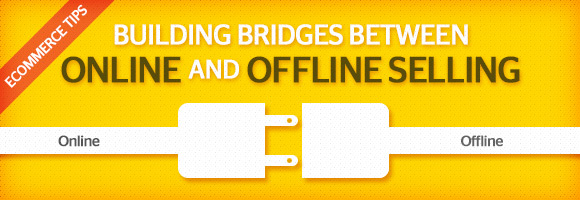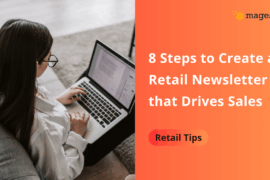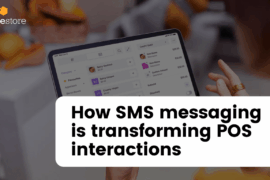In this Internet age, we have to deal with the fact that customers are very demanding (yes, that means you, me, plus everyone else for this matter). Some prefer the personal and social experience of shopping offline while others like ease of use and convenience of online retail, and quite often people are a combination of both. That means integrating online and offline allows for a richer, more complete experience for your customer. However, how to build a bridge between two distant worlds and maximize the benefit from “Bricks and Clicks” model? Well, keep the following in mind:
Target: Keep all channels consistent
Without a doubt, the biggest problem associated with integrating online and offline retail channels is discrepancies in price and inventory between the store and Web site, as retailers can’t possibly maintain the same inventory in-store that they do on the Web. Imagine how annoyed customers would be if they’ ve made the trip to your in-store and find out that the item they’ve ordered is unobtainable, or there’s no record of a purchase? All because your processes aren’t sophisticated enough to cope with their.
Let’s admit that integrating the order management and CRM systems between your different channels will help you remove this disconnect between offline and online purchases. Both channels accessing information from the same pool of data means that you will only need to enter details once and they will be updated in real time across your business. You’ll be much more efficient and your customers will be happier too!
This consistency should extend beyond merely similar visual branding. It should include your returns policy, service promises, warranties etc, this way customers can be confident in their assumptions that both channels are actually two parts of the same brand.
How to do it?
There are pros and cons to both the online and offline channels, then how do you get around them? Have both of course – that way you cover all your bases. Obviously, this leads to a lot more work so you may need to start with one and then implement the other.
Step 1: Give your website a workout
When it comes to your website as a sales channel, the quality is what will make or break it. You need to build your customer’s trust of your business and having a top-notch design is a big part of this. It needs to look beautiful, fit with your brand and be simple to navigate. It needs to run quickly too, so don’t bulk it out with unnecessary good or huge images. There’re plenty of Magento extensions out there to complete this task for you. For example, Magento mega menu, Magento banner pro, Magento shop by brand etc.
Your product pages also need to be clear and easy to read (with good spelling and grammar), make sure visitors can quickly and easily find all the information they might need in order to convert into a customer. All items should have a variety of good quality images too. Need some suggestions? Magento Image option, Magento product file upload… will do the trick.
For your checkout process, it should be very easy to find with a clear call-to-action button for them to click on in order to make the purchase, and don’t forget to make your shipping policy easy to find as well. The checkout itself must be straightforward to complete too. Remove any blockers or distractions that might holding up the process or drive customers away like registration or login, and build trust by displaying secure payment method on the page. All these requires will be fulfill with just 1 extension: Magento One step checkout! But you always can maximize add-on benefit with other modules, such as Magento social login, Magento Facebook login, Magento store pickup…
Step 2: Integrated inventory
By having one central inventory management system, you gain the ability for real time information about products to be automatically updated across all your sales channels. This way you’ll never accidentally sell the same product twice, leaving one customer disappointed waiting for a new item to come into your warehouse. Shipping is on time, every time, so your customers get what they want when you promised it to them. You only need to update a product’s details once rather than multiple times, saving you more time to sell more.
On the other hand, POS (point of sale) software can speed up efficiencies when it comes to sales. You are able to synchronize your cash till(s) to your inventory meaning your staff can access any information about your products, such as price, location, and availability, right from the till. You are able to speed up the process of making sales, and can answer customer’s questions extremely quickly. Staffs are less frustrated, customers are more satisfied, and you gain extra to make more sales! And you know what, Magento Web POS is designed specifically to assist you in this task.
Step 3: Customer service is the key!
If you can get this right, you will find that the likelihood of customer’s coming back next time they need something you sell, and they won’t mind to spread the word about your business too. You can use discounts and other incentives to encourage them to come back even more, either by giving them a discount on a receipt at the till, or by send deals via email. Magento reward points, Magento daily deal, Magento group deal, Magento Price bargain… are some helping hands for you.
Another problem is what if you are unable to set the same price in store and on site. Fortunately, the answer is a simple solution – it’s all about communication. Your customers are savvy people, they will understand that selling online is better for your bottom line and will appreciate you passing these savings on when they buy from your online store. But they’ll only understand this difference if you explain it them. Keep the customer informed of differences between the store and the Web and they will appreciate your time to notify them. A good website with an efficient checkout process (and good products!) are essential in any e-commerce venture; but good old-fashioned service and paying attention to details are, ultimately, what matters.
The above list is by no means exhaustive; there will always be challenges to overcome and conflicts to resolve. Nevertheless, if you follow some of suggestions above, you will dramatically increase the chance of integration. Please share your experience for this matter in comments and see you next time in Magento E-commerce tips!




